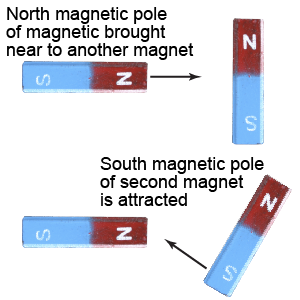|
Magnets are found in many objects we use every day, such as motors. Permanent magnets maintain their magnetic activity even when not in the presence of other magnets. Some magnetic materials can be temporarily magnetized by the presence of an external magnet. Magnets always have two different magnetic poles, which we call north and south. The force between magnetic poles is attractive between unlike poles and repulsive between like poles. The magnetic force becomes very strong as magnets are brought close together. Magnetic field lines are a tool for visualizing how magnetic fields vary in the space around a magnet. The planet Earth has a magnetic field. The south magnetic pole of Earth’s magnetic field is close to, but not exactly aligned with, the planet’s north geographic pole. The difference between geographic and magnetic north is called declination. Electricity and magnetism are connected with each other because electric current creates a magnetic field. 
|
|
magnetic, magnetism, permanent magnet, magnetize, magnetic force, magnetic poles, polarity, force field, magnetic field, magnetic field lines, ferromagnetic, magnetic domains
|
Review problems and questions |
|
- A teacher needs to store two strong permanent magnets in a box. The problem is that they attract each other, stick together, and are very hard to separate. Describe a way to store the two magnets in the same box so that they can be easily separated.

 |
The magnetic force between two magnets increases quickly when the magnets become closer and closer to each other. Insert a nonmagnetic material, such as a sheet or block of plastic or wood, between the two magnets to prevent them from becoming too close to each other. The plastic can be held together like a sandwich by the (weaker) magnetic force between the two permanent magnets. (Pairs of bar magnets should be stored with their unlike poles opposite each other, and with soft iron “keepers” across their ends to preserve the magnets’ strength.) 
|
- The north magnetic pole of a bar magnet is brought near the middle of a second bar magnet, i.e., halfway between its north and south magnetic poles. The second magnet is observed to spin by 90°. In what direction does it spin? Why? Draw a diagram to illustrate your answer.

 |

The second bar magnet spins in a direction that causes its south magnetic pole to move toward the first bar magnet, because opposite poles attract. 
|
- What is the cause of Earth’s magnetic field?

 |
The exact cause of Earth’s magnetic field is not reliably known. The core of the Earth cannot be solid metal like a bar magnet but is molten because of the extreme heat and pressure. Scientists have generally concluded that vast electric currents flowing in the molten metal of the planet’s core create Earth’s magnetic field by electromagnetic effects. 
|
- Describe the outcome of an experiment in which a student tries to create an isolated north magnetic pole by breaking off the north pole of a permanent magnet.

 |
The broken piece will always have a north pole and a south pole. Magnetic poles cannot be isolated from each other. 
|
- Which pole of a bar magnet will attract a paper clip? Why?

 |
Both ends of a bar magnet attract a paper clip. The metal in a paper clip can be magnetized in the presence of a magnet—either magnetic pole end of a magnet. That is why both sides of refrigerator magnets stick onto a refrigerator door. 
|
- A typical bar magnet is placed on a table, approximately 10 cm away from a pile of iron filings.
- Does the bar magnet or the Earth produce a greater contribution to the magnetic field in the vicinity of the iron filings?
- How can you test your answer?

 |
- The magnetic field from a typical bar magnet will be stronger at this distance.
- Test this by placing a compass at this location and observing which of the magnetic fields has the greater effect on the orientation of the compass needle.

|
- Which of these actions would be more likely to weaken the magnetic field of a bar magnet: placing it in a warm oven or placing it in the freezer? Why?

 |
Heating the magnet by placing it in a warm oven will weaken the field by disrupting the orderly arrangement of atoms within the magnetic domains. 
|
- We know that like magnetic poles repel each other. Yet the north pole of a compass needle points roughly toward the Earth’s North Pole. Why?

 |
Earth’s geographic north pole nearly coincides with Earth’s magnetic south pole. The north end of compass needles are attracted toward a south magnetic field; hence they are attracted toward the Earth’s south magnetic pole—which is not far away from the Earth’s north geographic pole. 
|
- How can you use a compass to determine direction?

 |
You can use the compass to determine the direction of magnetic north. Assuming you know your approximate geographical location, you can then make a small correction to determine the direction of true north. 
|
Take a Quiz |

